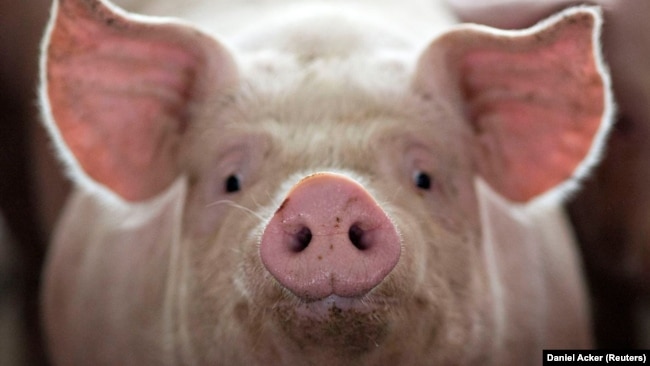”ベイブ”を思い出させるこの豚ちゃんの可愛い顔!!
画像だけで、’豚は音楽が好き’ みたいな記事かな?って思ったら
そのタイトル見て!!! こ、これは!!!!
VOAで早速学びましょう!!
研究成果 :ブタの死後、細胞機能を回復させることに成功(和訳)
Study: Cell Function Restored in Pigs after Death
August 07, 2022
豚の組織を使った実験から、死後1時間後に組織を保存し、細胞が働く能力を回復できることが示唆されたと研究者らが発表しました。
米エール大学の研究チームによるこの研究は、このほど科学誌Natureに掲載されました。
研究チームは、今回の実験技術により、臓器移植を必要とする患者が利用できる臓器の数を増やすことができる可能性を示唆しました。
実験では、研究者たちは数匹のブタの心臓を停止させました。1時間後、ブタに専用の機械を取り付け、代用血液を体中に送り込みます。この液体には、血液の一部と、細胞の活動を助け、炎症を抑えるための13種類の化学物質が含まれています。
6時間後、この治療により、心臓が血液を送り出すのを止めたときに生じる酸素不足によるダメージの一部が軽減またはキャンセルされました。例えば、臓器の炎症や血管の崩壊が減少したり、修正されたりしたと科学者たちは言います。
研究者らはこの治療法をOrganExと呼んでいます。
この結果は、心臓が停止しても、”これまで想定していたほどには、身体は死んでいない”ことを示している、とズボニミール・ヴルセルヤ氏は話します。彼は、記者団の取材に応じたエール大学の研究論文の執筆者の一人です。「我々は細胞が死なないことを説くことができることを示すことができました。」と彼は付け加えました。
この研究の中で、科学者達は、組織の遺伝子検査から、循環が戻された時点で、細胞を修復するプロセスが始まったことが示唆されたと述べています。
研究者らによれば、実験中、豚は脳の電気的活動の痕跡を見せなかったと言います。
彼らは、OrganExが、回復不可能な重篤な脳損傷を負ったドナーから生命維持装置を取り外して採取した臓器の利用が拡大することを期待しています。血液が循環しなくなることで起こる臓器へのダメージを防ぐのが目的です。
現在、脳死状態で生命維持装置を解除したドナーから採取した臓器は、血液が循環しているドナーから採取した臓器に比べて性能が劣ると言われています。
しかし、OrganExを人間の臓器に使用するのは、何年も先のことになるかもしれない。
スティーブン・レイサム氏はイェール大学の学際的生命倫理センターの研究者です。彼は、この研究の結果は、生命維持に必要な”機能レベルまで臓器が回復したというには程遠い”と述べています。
理論的には、この技術はいつか死んだばかりの人を生き返らせるために使われるかもしれない、と言う意見もあります。
レイサム氏は、「そのためには、もっと多くの実験が必要です。」と言っています。さらに、「そして、人間がよみがえる状態とはどのようなものかを考えなければならないでしょう。」と付け加えています。
レイサム氏は、OrganExを臓器移植に使用することがより現実的な目標であると述べています。さらに、OrganExを患者の医療行為に使用することは、"ずっと先のことになるだろう "と付け加えました。
Study: Cell Function Restored in Pigs after Death
Researchers say experiments on pig tissue suggest that tissue can be preserved and cells can regain the ability to work an hour after death.
The study, by a team of Yale University researchers in the United States, recently appeared in the scientific publication Nature.
The researchers suggested that their experimental technology could help increase the number of organs available to patients who need organ transplants.
In the experiment, the researchers stopped the hearts of several pigs. After an hour, the animals were attached to a specialized machine which pumped a blood substitute through their bodies. The fluid contained some blood and about 13 chemicals meant to support cell activity and decrease inflammation.
Six hours later, the treatment had reduced or cancelled some of the damage that resulted from lack of oxygen when the heart stopped pumping blood. For example, organ inflammation and collapsed blood vessels had reduced or were corrected, the scientists said.
The researchers call the treatment OrganEx.
The results showed that when the heart stops, the body is “not as dead as we previously assumed,” Zvonimir Vrselja said. He is one of the writers of the Yale University study who spoke with reporters. He added, “We were able to show that we can persuade cells not to die.”
In the study, the scientists said genetic examination of the tissue suggested that the process of repairing cells began once circulation was brought back.
The researchers said that during the experiment, the pigs showed no evidence of electrical activity in the brain.
They hope OrganEx will permit increased use of organs taken after withdrawal of life support from donors with severe brain injuries they cannot recover from. Their aim is to prevent damage to organs that happens when blood stops circulating.
Currently, organs taken from brain-dead donors who were taken off life support systems do not perform as well as those taken from such donors with circulating blood.
Using OrganEx on human organs, however, could be years away.
Stephen Latham is of Yale's Interdisciplinary Center for Bioethics. He said the result of the study “stops far short of saying that any organs were restored to the level of function” necessary to support life.
Some observers are suggesting that, in theory, the technology could someday be used to bring someone who has just died back to life.
Latham said, “In order to do that, there's a great deal more experimentation that would be required.” He added, “And you'd have to think about what is the state to which a human being would be restored.”
Latham said use of OrganEx in organ transplants is a more realistic goal. He added, any use of OrganEx in a medical treatment of a patient “is going to be a long ways away.”
Words in This Story
transplant – v. to perform a medical operation in which an organ or other part that has been removed from the body of one person is put into the body of another person
inflammation – n. a condition in which a part of your body becomes red, swollen, and painful
vessel – n. a vein or artery that carries blood through the body
assume – v. to think that something is true or probably true without knowing that it is true
donor – n. a person who gives something (such as blood or a body organ) so that it can be given to someone who needs it
function –n. the activity, purpose or job that something or someone does
